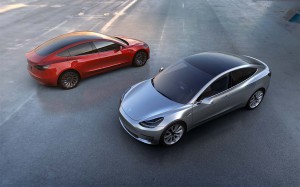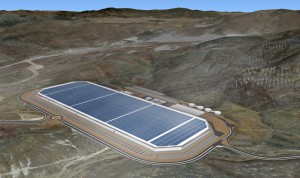Despite growing concerns among industry analysts, investors haven’t given up on Tesla. Anything but.
Wall Street came up with another $1.2 billion in capital for the Silicon Valley battery-carmaker this week as it went back for an infusion aimed at helping complete development of the critical new Model 3 SUV set to go into production in July. And it’s possible the figure could climb to $1.4 billion.
The latest stock offering went off barely a year after Tesla’s previous turn to the market, and was meant to “reduce any risks associated with the rapid scaling of (our) business due to the launch of Model 3, as well as for general corporate purposes,” the company said. It also came just weeks after Tesla CEO Elon Musk warned that the maker’s finances were “getting very close to the edge.”
Tesla has been spending heavily this past year, not only on the Model 3’s development but to move forward with the $5 billion Gigafactory battery plant it is setting up near Reno, Nevada. Add to that the challenging and controversial takeover of Solar City, the solar power company started by members of the Musk family.
The new offering included both common stock and convertible senior notes and was expected to raise about $1 billion. In the end, the figure jumped to $1.2 billion. But it could actually come in slightly higher.
The underwriters — Goldman Sachs, Deutsche Bank, Citigroup, Morgan Stanley, Barclays, Merrill Lynch and Credit Suisse — now have a 30-day option to purchase an additional 15% of each offering. Some of Tesla’s earlier stock sales were oversubscribed. But whether that will happen this time is less certain.
(More worries at Tesla strains finances rushing to launch Model 3. For more on the launch, Click Here.)
In recent weeks, long-bullish analysts have started turning bearish on Musk and company, David Tamberrino, of Goldmah Sachs, downgrading Tesla shares to “sell.” After the latest offering was announced, CFRA’s Efraim Levy reiterated his own “sell” recommendation, warning that “risks persist” for Tesla.
The biggest is the upcoming launch of the Model 3, Tesla’s first long-range, mainstream-priced battery-electric vehicle, or BEV. It says it has taken somewhere in the range of 400,000 advance registrations for the vehicle, so getting it into the market as soon as possible is critical. But Tesla has a history of missing its launch dates. It was two years behind with the Model X, and that electric SUV was beset with quality issues that depressed production at Tesla’s Fremont, California assembly plant last year.
During an earnings conference call last month, CEO Musk stressed that the sedan will go into production in July, about as early as anyone had been hoping for. But skeptics still abound. And automotive analysts like David Sullivan, of AutoPacific Inc., warn that getting quality right will be just as important as delivering the Model 3 on time. Sullivan warns that mainstream buyers are, ironically, far less tolerant of defects than luxury buyers, who typically have another vehicle to switch to when a car like the Model X has to go in for service.
(Tesla posts Q4 and full year loss. Click Here for the story.)
To help shore up investor confidence in the latest stock offering, Tesla CEO Musk said he will purchase $25 million worth of those new common shares.
That appears to have worked. Not only did Tesla raise more than expected with this week’s offering, but its share price has risen nearly $20 this week, reaching around $264 as of midday Friday on the New York Stock Exchange. That is still down from a 52-week high of $287.39, however.
Musk has repeatedly billed the Model 3 as the breakthrough vehicle for Tesla. It certainly needs to change its numbers. While production last year nearly doubled 2015’s numbers, the Silicon Valley maker is still barely an asterisk on industry sales charts. But Musk has promised to push volume to 500,000 in 2018 and 1 million by 2020.
Margins will be significantly tighter on the Model 3, which will start at around $35,000 after factoring in the federal $7,500 tax credit. But at the sales levels promised, Tesla is expected to finally land solidly in the black. It has turned a quarterly profit only twice since going public. And while it was able to halve its deficit, year-over-year, it still lost $121.3 million, or 78 cents a share, during the final quarter of 2016.
Another challenge for Tesla is the integration of SolarCity, the solar cell company it now owns following last year’s controversial acquisition.
Observers have also expressed concerns that Musk’s attention is getting spread thin. He not only owns Tesla but the rocket launch company SpaceX. And he serves on two economic advisory boards set up by President Donald Trump. A boycott against Tesla launched in protest of Musk’s ties to the GOP White House resulted in the cancellation of a small number of Model 3 reservations, Tesla confirmed last month.
(UAW gearing up for organizing battle with Tesla. Click Here for the story.)



Kind of ironic that GS has been the biggest, loudest and longest negative of Tesla yet they are now an underwriter
They are going to have to realize that a volume car will bring its own issues. Jalopnik has pointed out the problems with current collision repair for Tesla; a theoretically popular Model 3 is going to make things worse.